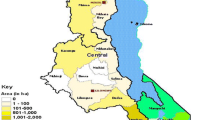Abstract
Based on the assumption that agricultural technologies were available and that the problem was their dissemination and adoption, U.S. development efforts have focused on establishing public-sector extension systems for farmers in developing countries. Evaluations of government extension services in developing countries, however, have found them to be largely ineffective, especially in helping small farmers. As a result, private-sector extension is increasingly receiving attention as an alternative approach. This paper examines various characteristics of public- and privatesector extension, drawing on both the literature and a case study of government extension and farm input stores in Imbabura province, Ecuador. It concludes with a discussion of the implications of increased privatization of extension.
Similar content being viewed by others
References
Agency for International Development. (1982). “Private Enterprise Development,” Washington, DC: AID Policy Paper.
Agency for International Development. (1987).Reorientation of the Agricultural Sector. Quito: A Joint Ecuadorean/N.C. State University Report.
Burbach, R. and P. Flynn. (1980).Agribusiness in the Americas. NY: Monthly Review Press.
Chambers, R. (1974).Managing Rural Development. Uppsala, Sweden: Scandinavian Institute of African Studies.
Huffman, W. and M. McNulty. (1985). “Endogenous Local Public Extension Policy,”American Journal of Agricultural Economics. Vol. 67, No. 4.
Hulme, D. (1983). “Agricultural Extension: Public Service or Private Business?”Agricultural Administration, 14, 65–79.
Jiggins, J. (1977).Motivation and Performance of Extension Field Staff. London: Overseas Development Institute.
McDowell, G. and D. Wilcock. (1985).Final Report: The Experiences of U.S. Universities in Building Colleges of Agriculture in Africa. Washington, DC: USAID-BIFAD.
McPherson, M. P. (1985). “Extension: Do We Really Have Anything Useful or New to Offer the Developing Countries?” In M. Andrews (ed),The International Role of Extension: Future Direction, Conference Highlights and Recommendations. East Lansing: Michigan State University.
Moris, J. (1983).Reforming Agricultural Extension Services in Africa. London: Overseas Development Institute.
Orivel, F. (1983).The Impact of Agricultural Extension Services: A Review of the Literature. Washington, DC: World Bank.
Preston, D. (1978).Farmers and Towns: Rural-Urban Relations in Highland Bolivia. Norwich: University of East Anglia.
Rice, E. B. (1971).Extension in the Andes. Washington, DC: USAID.
Rodgers, W. (1987). “The Private Sector: Its Extension Systems and Public/Private Coordination,” in W. Rivera and S. Schram (eds),Agricultural Extension Worldwide. NY: Croom Helm.
Rogers, E. (1969).Modernization Among Peasants—The Impact of Communication. NY: Holt, Rinehart & Winston.
Ruttan, V. (1982).Agricultural Research Policy. Minneapolis: University of Minnesota Press.
Santana, R. (1983).Campesinado Indigena y el Desafio de la Modernidad. Quito: CAAP.
Stavis, B. (1979).Agricultural Extension for Small Farmers. East Lansing: Michigan State University.
Woods, B. (1983).Altering the Present Paradigm: A Different Path to Sustainable Development in the Rural Sector. Washington, DC: World Bank.
Whyte, W. F. (1981).Participatory Approaches to Agricultural Research and Development. Ithaca, NY: Cornell University.
York, E. T. (1985). “International Technology Development and Transfer,” in M. Andrews (ed),The International Role of Extension: Future Directions, Conference Highlights and Recommendations. East Lansing: Michigan State University.
Additional information
L. Van Crowder is an assistant professor in the Editorial Department, Institute of Food and Agricultural Sciences (IFAS), University of Florida. His international experience includes working as an extension/rural communication specialist in Bolivia, Honduras, Costa Rica, and Ecuador. Most recently (1986), he completed a regional analysis of public and private sector agricultural knowledge systems in Ecuador.
Rights and permissions
About this article
Cite this article
Van Crowder, L. Agents, vendors, and farmers: Public and private sector extension in agricultural development. Agric Hum Values 4, 26–31 (1987). https://doi.org/10.1007/BF01530499
Issue Date:
DOI: https://doi.org/10.1007/BF01530499




